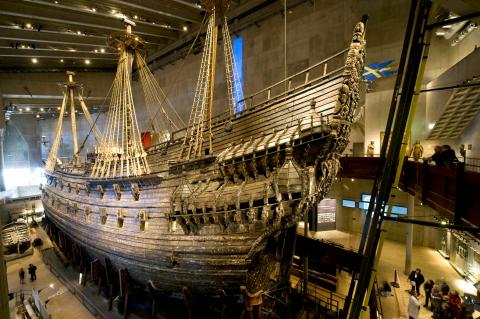A half-century has passed since the sunken 17th-century royal warship Vasa was brought to the surface, but the story of how one of Sweden’s biggest failures became a national treasure still fascinates.
“The first thing we saw was a little wooden head and after some time came another wooden head ... It was a fantastic sight,” retired navy commander Jarl Ellsen said ahead of today’s 50th anniversary of the raising of the ship.
Slowly, what was once briefly the crown jewel of the Swedish navy was raised off the Baltic sea bed where it had rested for more than 300 years after pitifully sinking just minutes into its maiden voyage.

Photo: AFP
For the large crowd gathered at the Stockholm harbor on April 24, 1961, and the about 100 million people following the event from around the world on television and radio, the suspense was enormous.
“We didn’t know how she would behave,” said 90-year-old Ellsen, who at the time was a spokesman for the Swedish Navy.
“It was very exciting. She came up rather slowly because they had to take it very, very easy not to break her,” he added.
More than three centuries earlier, the Vasa, commissioned by Swedish King Gustav II Adolf to be the mightiest warship in the world, set sail in the late afternoon of Aug. 10, 1628, on its maiden voyage.
After raising its massive sails and firing celebratory canon shots in front of the royal palace in Stockholm, the ship majestically glided off, only to discover after a few minutes and a mere 1km out, it did not have enough ballast to counteract the weight of its 64 guns.
“The Vasa story is the story of a historic fiasco,” said Marika Hedin, a historian and head of the Vasa Museum, today by far Sweden’s most visited museum.
Managing to raise the 69m wreck nearly intact — the first ever underwater salvage of such a large vessel — “gave the ship back its symbolic meaning for Sweden as a success story,” she said.
“It was an absolutely crazy project,” Hedin said, pointing out that at the time the salvage began, no one had any idea if it would even be possible, how much it would cost or if the ship would remain intact.
Yet the enthusiasm around the project was enormous.
“I think the idea was to salvage her and also to rewrite the history around her, to make her an example and the symbol of those greater days” in Sweden’s glory period during the reign of Gustaf II Adolf, she said.
Swedish military circles were eager to revamp the Scandinavian country’s image felt by many to have been tainted by what they saw as its “cowardice” in remaining neutral throughout World War II, Hedin added.
Vasa’s second life began in 1956 when navy engineer Anders Franzen located the wreck at a depth of 32m.
He had been looking for the all-but-forgotten warship, knowing that the Baltic Sea was perfect for preserving wrecks due to the fact that the teredo, a wood-penetrating ship worm, is absent from its icy, brackish waters.
In fact, today about 20,000 ship wrecks have already been discovered at the bottom of the Baltic, while archeologists suspect there could be more than 100,000.
Far fewer were known of when Franzen began his tireless search, using a special core sampler which, after years of patience, one day pulled up a piece of blackened oak from a depth of about 30m.
Diver Per Edvin Faelting plunged in and quickly contacted Franzen by radio.
“I can’t see anything, since it’s pitch-dark here, but I can feel something big — the side of a ship,” he said. “Here is one gun port and here’s another. There are two rows. It must be the Vasa.”
Soon ideas — many of them far-fetched — of how to bring the majestic rig to the surface were being tossed around: Should they freeze the ship and the water around it before raising it and letting the iceberg melt in the sun or perhaps fill it with ping-pong balls that would help float it to the surface?
In the end, it was decided to slip massive steel cables under the hull and lift the wreck out of the water.
However, digging out the seabed beneath the hull to make room for the cables was no small feat, with the divers constantly fearful the massive ship would collapse on top of them.
“We were military divers and we were given an order to dive,” Aake Lindquist said, acknowledging that at the time he was just 19 and “didn’t know how exciting it was.”

In the sweltering streets of Jakarta, buskers carry towering, hollow puppets and pass around a bucket for donations. Now, they fear becoming outlaws. City authorities said they would crack down on use of the sacred ondel-ondel puppets, which can stand as tall as a truck, and they are drafting legislation to remove what they view as a street nuisance. Performances featuring the puppets — originally used by Jakarta’s Betawi people to ward off evil spirits — would be allowed only at set events. The ban could leave many ondel-ondel buskers in Jakarta jobless. “I am confused and anxious. I fear getting raided or even

Kemal Ozdemir looked up at the bare peaks of Mount Cilo in Turkey’s Kurdish majority southeast. “There were glaciers 10 years ago,” he recalled under a cloudless sky. A mountain guide for 15 years, Ozdemir then turned toward the torrent carrying dozens of blocks of ice below a slope covered with grass and rocks — a sign of glacier loss being exacerbated by global warming. “You can see that there are quite a few pieces of glacier in the water right now ... the reason why the waterfalls flow lushly actually shows us how fast the ice is melting,” he said.

Eleven people, including a former minister, were arrested in Serbia on Friday over a train station disaster in which 16 people died. The concrete canopy of the newly renovated station in the northern city of Novi Sad collapsed on Nov. 1, 2024 in a disaster widely blamed on corruption and poor oversight. It sparked a wave of student-led protests and led to the resignation of then-Serbian prime minister Milos Vucevic and the fall of his government. The public prosecutor’s office in Novi Sad opened an investigation into the accident and deaths. In February, the public prosecutor’s office for organized crime opened another probe into

RISING RACISM: A Japanese group called on China to assure safety in the country, while the Chinese embassy in Tokyo urged action against a ‘surge in xenophobia’ A Japanese woman living in China was attacked and injured by a man in a subway station in Suzhou, China, Japanese media said, hours after two Chinese men were seriously injured in violence in Tokyo. The attacks on Thursday raised concern about xenophobic sentiment in China and Japan that have been blamed for assaults in both countries. It was the third attack involving Japanese living in China since last year. In the two previous cases in China, Chinese authorities have insisted they were isolated incidents. Japanese broadcaster NHK did not identify the woman injured in Suzhou by name, but, citing the Japanese